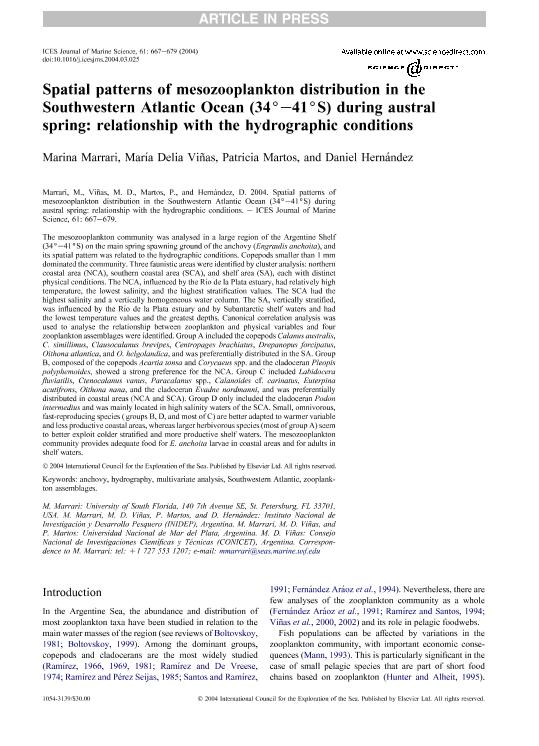Artículo
Spatial patterns of mesozooplankton distribution in the Southwestern Atlantic Ocean (34(e41(S) during austral spring: relationship with the hydrographic conditions
Fecha de publicación:
03/2004
Editorial:
Oxford University Press
Revista:
ICES Journal of Marine Science
ISSN:
1054-3139
Idioma:
Inglés
Tipo de recurso:
Artículo publicado
Clasificación temática:
Resumen
The mesozooplankton community was analysed in a large region of the Argentine Shelf (34(e41(S) on the main spring spawning ground of the anchovy (Engraulis anchoita), and its spatial pattern was related to the hydrographic conditions. Copepods smaller than 1 mm dominated the community. Three faunistic areas were identified by cluster analysis: northern coastal area (NCA), southern coastal area (SCA), and shelf area (SA), each with distinct physical conditions. The NCA, influenced by the R ́ıo de la Plata estuary, had relatively high temperature, the lowest salinity, and the highest stratification values. The SCA had the highest salinity and a vertically homogeneous water column. The SA, vertically stratified, was influenced by the R ́ıo de la Plata estuary and by Subantarctic shelf waters and had the lowest temperature values and the greatest depths. Canonical correlation analysis was used to analyse the relationship between zooplankton and physical variables and four zooplankton assemblages were identified. Group A included the copepods Calanus australis, C. simillimus, Clausocalanus brevipes, Centropages brachiatus, Drepanopus forcipatus, Oithona atlantica, and O. helgolandica, and was preferentially distributed in the SA. Group B, composed of the copepods Acartia tonsa and Corycaeus spp. and the cladoceran Pleopis polyphemoides, showed a strong preference for the NCA. Group C included Labidocera fluviatilis, Ctenocalanus vanus, Paracalanus spp., Calanoides cf. carinatus, Euterpina acutifrons, Oithona nana, and the cladoceran Evadne nordmanni, and was preferentially distributed in coastal areas (NCA and SCA). Group D only included the cladoceran Podon intermedius and was mainly located in high salinity waters of the SCA. Small, omnivorous, fast-reproducing species ( groups B, D, and most of C) are better adapted to warmer variable and less productive coastal areas, whereas larger herbivorous species (most of group A) seem to better exploit colder stratified and more productive shelf waters. The mesozooplankton community provides adequate food for E. anchoita larvae in coastal areas and for adults in shelf waters.
Palabras clave:
Anchovy
,
Hydrography
,
Multivariate Analysis
,
Southwestern Atlantic
Archivos asociados
Licencia
Identificadores
Colecciones
Articulos(CCT - MAR DEL PLATA)
Articulos de CTRO.CIENTIFICO TECNOL.CONICET - MAR DEL PLATA
Articulos de CTRO.CIENTIFICO TECNOL.CONICET - MAR DEL PLATA
Articulos(IIMYC)
Articulos de INSTITUTO DE INVESTIGACIONES MARINAS Y COSTERAS
Articulos de INSTITUTO DE INVESTIGACIONES MARINAS Y COSTERAS
Citación
Marrari, Marina; Viñas, Maria Delia; Martos, Patricia; Hernandez, Daniel; Spatial patterns of mesozooplankton distribution in the Southwestern Atlantic Ocean (34(e41(S) during austral spring: relationship with the hydrographic conditions; Oxford University Press; ICES Journal of Marine Science; 61; 3-2004; 667-679
Compartir
Altmétricas




